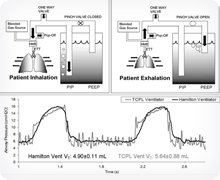Hansen Ventilator
Rethinking Old Technology to Save Newborns

The operational mechanism of the Hansen Vent and its effect on the lungs.
The NeoRest team is investigating ways to provide greater respiratory support by redesigning old technology so that it is more appropriate and affordable for resource-limited healthcare settings.
Mechanical ventilation is the best method for providing oxygen to infants who have no ability to breathe on their own. Unfortunately, this vital therapy is often unavailable in resource-limited healthcare facilities due to the high cost of the technology. Devices like Seattle-PAP provide an infant with respiratory support; however, an infant on Seattle-PAP must be able to breathe independently for the device to work. If an infant becomes exhausted, their breathing rate is too fast or too slow or their lungs lose volume, they lose the ability to breathe independently and must receive mechanical ventilation to survive.
By modifying the technology used in today's mechanical ventilators, the NeoRest team has been able to create a ventilator for a fraction of the cost of currently available equipment. This device, called the Hansen Ventilator, after its co-inventor Dr. Thomas Hansen, Seattle Children's Hospital former CEO, uses similar principles to Seattle-PAP but adds a second tube placed deeper in the water and a pinch valve to control the frequency and duration of each gas "breath" the infant receives.
The components required to build the Hansen Ventilator are low-cost and easy to obtain, maintain and replace. The simple-to-operate device provides an innovative and potentially game-changing method for providing mechanical ventilation to infants in developing countries. This device has huge catalytic potential, and is currently undergoing testing and design refinement.